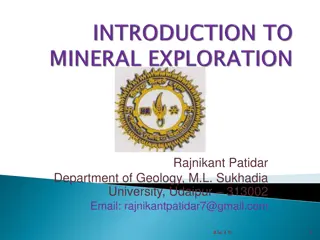Understanding Textures of Igneous Rocks in Geology
Structures associated with igneous rocks are primary features that contribute to their strength, distinguish rock groups, and reveal origin. Textures, like crystalline patterns, indicate cooling and crystallization processes. Different cooling rates lead to varied textures such as holocrystalline, holohyaline, and merocrystalline, affecting the rock's composition. These features are essential for studying the formation and properties of igneous rocks.
Download Presentation

Please find below an Image/Link to download the presentation.
The content on the website is provided AS IS for your information and personal use only. It may not be sold, licensed, or shared on other websites without obtaining consent from the author. Download presentation by click this link. If you encounter any issues during the download, it is possible that the publisher has removed the file from their server.
E N D
Presentation Transcript
TEXTURES OF IGNEOUS ROCKS Dr. A.V.Tejankar Professor & Head Dept. of Geology Deogiri College, Aurangabad
Structures and Textures Structures associated with the rocks. They are generally primary in nature. i.e.. they occur along with the formation of rocks and are important because. (i) the contribute to the strength or weakness of rocks. (ii) they serve as distinguished features of rock groups. (iii) They reveal the mode of origin of rock concerned. Textures on the other hand refers to small scale features like porphyritic texture and interlocking texture which can be studied in hand specimen. and textures are physical features
Common Texture of Igneous Rocks The term texture mainly refers to the mutual relationships of the constituents minerals in a rock in addition to crystalline, granularity, and shapes of minerals in a rock. Texture based on the degree of crystallinity Igneous rocks are formed due to cooling and solidification of magma and crystallization of different minerals takes place when respective molecules in magma move to their center of Crystallization and arrange themselves in a definite pattern. If reasonable time is available, crystallization of different minerals take place from the melt giving rise to a rock.
Common Texture of Igneous Rocks But if sudden chilling of lava occurs, then there may not be any time for crystallization to take place. Under such conditions, lava solidifies as completely amorphous or glassy matter without any minerals. On the other hand, if cooling time is intermediate, then the resulting rock will be composed partly of glassy matter and partly of minerals.
Common Texture of Igneous Rocks Thus, depending on the nature of cooling the resulting igneous rocks are (i) Completely crystalline (ii) Completely glassy (iii) partly crystalline and partly glassy Thus the preceding three different types of crystallization give rise to three textures of igneous rocks namely; Holocrystalline,holohyaline, and merocrystalline.
Common Texture of Igneous Rocks Texture Based on Granularity Depending on the physical condition that had during the crystallization of magma, minerals grain occur in different sizes. The presence slow cooling and great pressure help to grow large minerals. The following textures have been recognized based on granularity of minerals. If minerals in the rock are big enough to be seen by the naked eye, the texture is described as phaneric texture. If minerals are too fine to be seen separately by the naked eye, the texture is described as aphanitic texture. prevailed of volatiles, low viscosity, the
Texture Based on Granularity
Common Texture of Igneous Rocks Texture based on shape of crystal These textures are of two different kinds; The first term of development of crystal faces or boundary outlines and the other with reference to the nature of the growth of the minerals. When the mineral is completely bounded by crystal faces it is called euhedral ; when crystal faces are absent, it is called anhedral and when only a part of the mineral is bounded by crystal faces it is called subhedral . Euhedral minerals are rather rare in nature. The c/s of euhedral minerals as seen in their thin sections appear with polygonal boundary outline, whereas in the case of anhedral minerals, they appear rounded or surrounded in thin sections.























